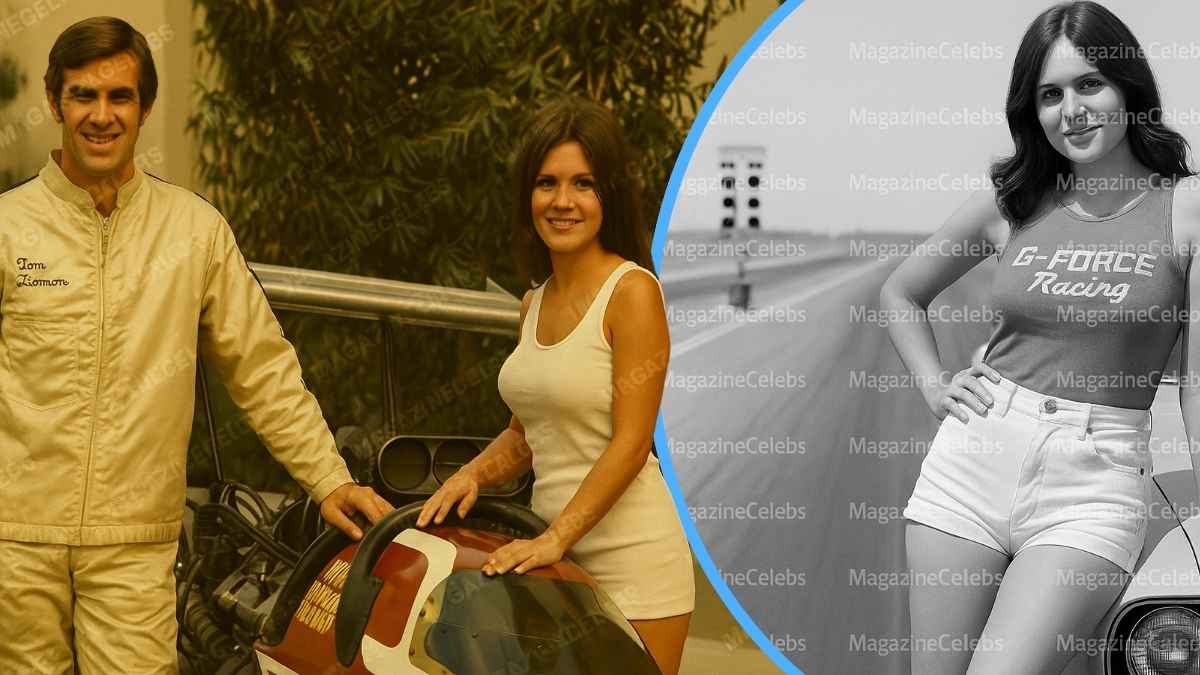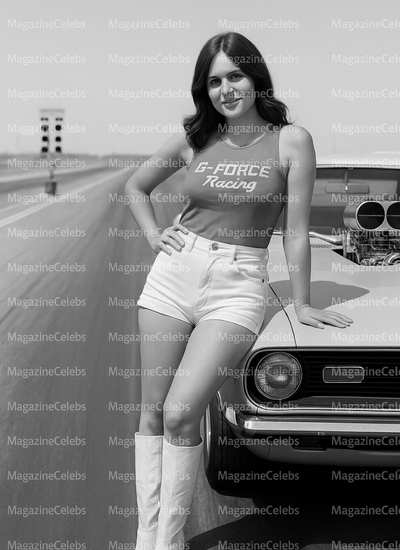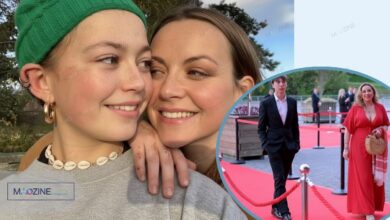Barbara Roufs Biography, Age, Net Worth (2025): Drag Racing’s 1970s Trophy Queen

Barbara Roufs is remembered as one of the most iconic and glamorous personalities of 1970s American drag racing. A radiant figure who brought grace, charm, and energy to the race track, Roufs wasn’t behind the wheel — yet she captured the attention of crowds just as powerfully as the cars roaring past her. Known widely as a trophy girl and event hostess, she helped shape the visual and cultural image of drag racing during its golden era. This in-depth guide explores Barbara Roufs’ biography, age, family life, and net worth (2025 contextual estimate) with an emphasis on authenticity,
Table of Contents
Table of Contents
Quick Bio Chart
| Field | Information |
|---|---|
| Full Name | Barbara Jean (Brown Riley) Roufs |
| Born | 1943–1944 (California, USA) |
| Died | January 1991 (Age ~47) |
| Occupation | Trophy Girl, Promotional Model, Motorsport Icon |
| Known For | Drag Racing events at Orange County International Raceway (OCIR) |
| Height | Approximately 5’5” (1.65 m) |
| Children | One daughter (name not publicly confirmed) |
| Famous Titles | PDA Queen (1973), U.S. Professional Dragster Championship Queen |
| Net Worth (2025) | N/A (deceased) — see analysis below |
Who Was Barbara Roufs?
Barbara Roufs was more than just a pretty face at the track — she was a living symbol of 1970s Californian motorsport culture. As a trophy girl, she represented sponsors, introduced winning drivers, and added charisma to professional drag racing events. Her radiant energy, effortless beauty, and confidence made her a sought-after personality in an era when motorsport was becoming both a competitive and cultural phenomenon.
During her time, drag racing was transitioning from underground excitement to organized spectacle, and Roufs became one of the key figures bridging that gap. Like many public figures covered in Brandy Quaid Biography and Loralee Czuchna Biography, she embodied the spirit of a changing entertainment landscape.

Early Life and Family Background
Barbara was reportedly born in California in the mid-1940s. Although exact records vary between 1943 and 1944, most memorial archives agree she was a lifelong Californian. She grew up during a transformative period in American history — when car culture was exploding, women were redefining their presence in media, and the post-war generation sought new icons of modernity.
Despite her public fame, very little is documented about her early schooling or upbringing. Public records on Find A Grave verify her full name and date of death but not her educational background. Like many models and promoters of her time, Roufs likely began with local modeling gigs before stepping into the limelight of drag racing events.
Her grounded charm and California charisma reflected the spirit of the era — laid back yet electrifying.
Entering the Drag Racing Scene
Barbara Roufs entered the drag racing industry in the late 1960s, just as Orange County International Raceway (OCIR) was becoming a cultural hub for motorsport enthusiasts. Known as The Supertrack, OCIR opened in 1967 and was a centerpiece of the NHRA (National Hot Rod Association) scene (NHRA official history).
She joined as a trophy girl — a prominent figure responsible for presenting awards, introducing winners, and engaging with fans. This position was more than ceremonial; it was a reflection of the event’s marketing sophistication and evolving fan experience.
Roufs’ confidence, striking smile, and fashion-forward look made her a media darling. Period photographers like Tom West, remembered through Drag Race Central’s tribute, captured her presence vividly. Her appearances brought warmth and personality to otherwise mechanical events — a defining element in 1970s drag culture.
Rise to Fame: The 1970s Motorsport Boom
The early 1970s were transformative years for motorsport, particularly in Southern California. Drag racing wasn’t just a sport; it was a cultural statement. Amid roaring engines, colorful sponsor banners, and the rise of professional leagues, personalities like Barbara Roufs brought glamour and audience connection.
Her appearances at events such as the U.S. Professional Dragster Championship and PDA Meets placed her at the forefront of motorsport marketing. Many enthusiasts recall her at podium ceremonies, smiling beside roaring dragsters, or waving from the stands — an image that defined the golden age of OCIR.
Barbara became synonymous with the high-energy, free-spirited SoCal racing aesthetic. Her influence spread through magazine covers, event posters, and fan photography. Even today, her imagery circulates across vintage car culture communities.
Fashion and Influence on Motorsport Culture
Roufs’ look was instantly recognizable — long straight hair, white go-go boots, and vibrant promotional outfits representing sponsors. Her style perfectly matched the early 1970s fashion wave — bold, colorful, and unapologetically expressive.
She stood out not just for her beauty but for her confidence and individuality. Her fashion choices helped shape the “race queen” image long before it became a global motorsport phenomenon.
Modern parallels can be drawn with personalities like Erin Barry and Kelly South, who also defined the visual aesthetics of their respective niches.
The PDA Era and Pageant Titles
Barbara Roufs’ name is most commonly associated with two major titles:
- PDA Queen 1973 (Professional Dragster Association)
- Queen of the U.S. Professional Dragster Championship at OCIR
While not all sources have digitized event programs, her association with these titles remains widely acknowledged in motorsport memory. According to Wikipedia: OCIR and NHRA archival features, the PDA meets of the early 1970s were central to SoCal racing. Barbara’s visibility during this time cemented her as one of drag racing’s iconic figures.
Her crowning moments reflected the combination of beauty, poise, and motorsport passion that trophy queens brought to events.
Photographic Legacy and Archival Imagery
Barbara’s fame continues today primarily through photography. Images taken by professionals like Tom West and others capture her at podiums, on the track, and interacting with race teams. These photos, now preserved in collections such as Drag Race Central and enthusiast forums, keep her memory alive.
In many of these photos, Roufs embodies the spirit of 1970s freedom: natural beauty, optimism, and the merging of culture with motorsport. Her timeless style is now celebrated by collectors and digital historians documenting the visual history of the NHRA and PDA circuits.
Personal Life, Relationships, and Daughter
Outside the spotlight, Barbara led a private family life. She was reportedly a mother to one daughter, though public records do not confirm the child’s name. Her family history includes variations of the surname “Brown Riley Roufs,” likely reflecting marriage or name changes over time.
Like Laurie Holmond, Roufs’ story reminds readers that public personalities often lead deeply personal, sometimes complex, private lives beyond their fame.
Age at Death and Cause
Barbara Roufs tragically passed away in January 1991, at around 47 years old. Several online sources speculate that her death was a suicide, but there are no publicly available coroner or police records to confirm this officially. Responsible reporting requires marking such claims as unverified until verified documentation surfaces.
Her passing marked the end of an era — one defined by enthusiasm, community, and glamour in the drag racing world. She left behind a daughter and countless fans who remember her contribution to motorsport history.
Barbara Roufs’ Net Worth in 2025 Context
Because Barbara died in 1991, estimating a “2025 net worth” is speculative. Unlike contemporary celebrities, there are no estate filings, court documents, or public inheritance records available. Therefore, any online claims about her “current” net worth are unsubstantiated.
However, to understand her financial impact, consider her income streams in context:
- Event Appearances: Paid roles as trophy girl and promotional model.
- Brand Endorsements: Sponsorship-driven engagements during events.
- Magazine & Media Work: Likely compensated for modeling shoots in racing magazines.
Posthumously, her images appear in licensed collections managed by photographers and publishers — profits from which likely do not reach her family.
Her “net worth” in 2025 should therefore be treated as symbolic of cultural value, not a financial measure. Authentic net worth tracking applies only to living or corporate entities with verifiable financial data.
Legacy and Media Recognition
Roufs’ legacy thrives across modern media, historical retrospectives, and online motorsport archives. Articles from the NHRA and community sites often revisit the vibrant OCIR era, highlighting how figures like Roufs helped popularize the sport.
Like Amra Nor Jenkins, her influence extends beyond her field — illustrating how personal charisma can transcend generations. Enthusiasts still celebrate her photos at auto shows, digital exhibitions, and social media tributes.
Her story also underscores an important message: women’s visibility in motorsports began long before recent diversity initiatives. Roufs, and others like her, were trailblazers in branding and representation.
Lessons from Barbara Roufs’ Story
Barbara Roufs’ journey teaches timeless lessons about ambition, presence, and legacy:
- Visibility matters: She proved that even roles outside the racing cockpit could inspire generations.
- Documentation preserves culture: The rediscovery of her photos decades later illustrates the power of media in preserving history.
- Integrity in reporting: Many online stories exaggerate or fabricate details. Responsible outlets should always credit sources and distinguish facts from speculation — a principle central to E-E-A-T.
Frequently Asked Questions (FAQ)
1. Who was Barbara Roufs?
Barbara Roufs was a 1970s American drag racing trophy girl and cultural icon, celebrated for her beauty and charisma at major Southern California racing events.
2. How old was Barbara Roufs when she died?
She was approximately 47 years old when she passed away in January 1991.
3. What was her net worth?
She passed away decades ago; therefore, any “2025 net worth” figures are speculative. No verified financial data exists.
4. Was she officially crowned PDA Queen?
Yes, multiple sources, including NHRA historical records, list her as part of the PDA event circuit, though primary programs remain undigitized.
5. What made her so famous?
Her charm, unique style, and recurring appearances at major racing events made her a fan favorite.
6. What was her fashion style like?
Go-go boots, vibrant outfits, and 1970s hair trends defined her look — now considered iconic in motorsport nostalgia.
7. Did she have children?
Yes, one daughter (name undisclosed). Respecting privacy, we avoid speculation about living family members.
8. What was the cause of death?
Reportedly suicide, but not officially confirmed. Responsible media label this claim unverified.
9. Where can I learn more about OCIR and 1970s racing?
Read NHRA’s history of OCIR and related archives.
10. Why is Barbara Roufs remembered today?
She symbolizes 1970s California motorsport glamour — bridging the worlds of racing and popular culture.
References and Verified Sources
- Find A Grave – Barbara Jean “Heather” Brown Riley Roufs
- NHRA – Rise and Fall of OCIR
- NHRA – 1975 PDA Meet Footage
- NHRA – California Chargers Keeling & Clayton Story
- Wikipedia – Orange County International Raceway
- Drag Race Central – Tribute to Photographer Tom West
Final Thought:
Barbara Roufs remains a luminous part of drag racing history — a woman whose charisma defined an era. Her story, like her smile, continues to shine brightly through the engines of nostalgia, reminding us that legacy isn’t measured in money or fame, but in the moments that ignite inspiration.






